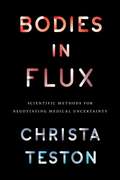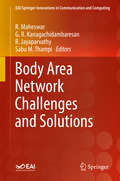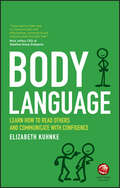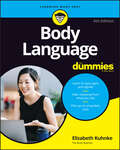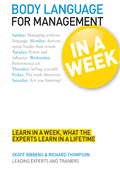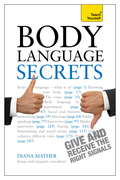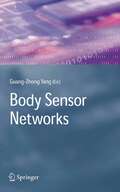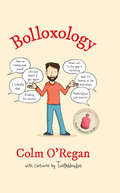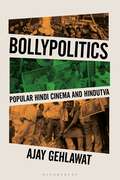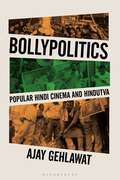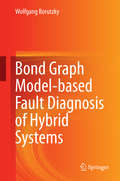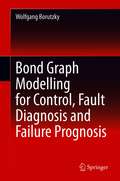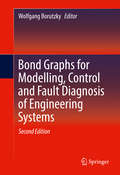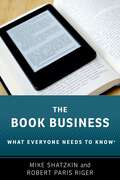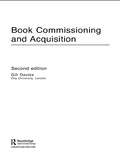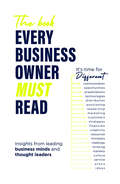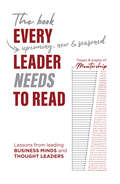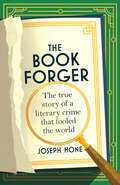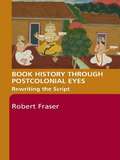- Table View
- List View
Bodies in Flux: Scientific Methods for Negotiating Medical Uncertainty
by Christa TestonDoctors, scientists, and patients have long grappled with the dubious nature of “certainty” in medical practice. To help navigate the chaos caused by ongoing bodily change we rely on scientific reductions and deductions. We take what we know now and make best guesses about what will be. But bodies in flux always outpace the human gaze. Particularly in cancer care, processes deep within our bodies are at work long before we even know where to look. In the face of constant biological and technological change, how do medical professionals ultimately make decisions about care? Bodies in Flux explores the inventive ways humans and nonhumans work together to manufacture medical evidence. Each chapter draws on rhetorical theory to investigate a specific scientific method for negotiating medical uncertainty in cancer care, including evidential visualization, assessment, synthesis, and computation. Case studies unveil how doctors rely on visuals when deliberating about a patient’s treatment options, how members of the FDA use inferential statistics to predict a drug’s effectiveness, how researchers synthesize hundreds of clinical trials into a single evidence-based recommendation, and how genetic testing companies compute and commoditize human health. Teston concludes by advocating for an ethic of care that pushes back against the fetishization of certainty—an ethic of care that honors human fragility and bodily flux.
Bodies in Flux: Scientific Methods for Negotiating Medical Uncertainty
by Christa TestonDoctors, scientists, and patients have long grappled with the dubious nature of “certainty” in medical practice. To help navigate the chaos caused by ongoing bodily change we rely on scientific reductions and deductions. We take what we know now and make best guesses about what will be. But bodies in flux always outpace the human gaze. Particularly in cancer care, processes deep within our bodies are at work long before we even know where to look. In the face of constant biological and technological change, how do medical professionals ultimately make decisions about care? Bodies in Flux explores the inventive ways humans and nonhumans work together to manufacture medical evidence. Each chapter draws on rhetorical theory to investigate a specific scientific method for negotiating medical uncertainty in cancer care, including evidential visualization, assessment, synthesis, and computation. Case studies unveil how doctors rely on visuals when deliberating about a patient’s treatment options, how members of the FDA use inferential statistics to predict a drug’s effectiveness, how researchers synthesize hundreds of clinical trials into a single evidence-based recommendation, and how genetic testing companies compute and commoditize human health. Teston concludes by advocating for an ethic of care that pushes back against the fetishization of certainty—an ethic of care that honors human fragility and bodily flux.
Body Area Network Challenges and Solutions (EAI/Springer Innovations in Communication and Computing)
by R. Maheswar G. R. Kanagachidambaresan R. Jayaparvathy Sabu M. ThampiThis book provides a novel solution for existing challenges in wireless body sensor networks (WBAN) such as network lifetime, fault tolerant approaches, reliability, security, and privacy. The contributors first discuss emerging trends of WBAN in the present health care system. They then provide possible solutions to challenges inherent in WBANs. Finally, they discuss results in working environments. Topics include communication protocols of implanted, wearable and nano body sensor networks; energy harvesting methodologies and experimentation for WBAN; reliability analysis and fault tolerant architecture for WBAN; and handling network failure during critical duration. The contributors consist of researchers and practitioners in WBAN around the world.
Body Language: Learn how to read others and communicate with confidence
by Elizabeth KuhnkeWhat does your body language say about you? From strangers on the street, to your closest friends and family – even if you're not speaking, you're saying a lot with your body. Body Language explores the way we use our bodies to communicate, the way we hold ourselves, the way we sit, stand, and point our hands, feet and eyes can all reveal how we are feeling in any given situation. This book explores the body language we use in a wide-range of business and personal-life scenarios, from delivering a presentation at work to how you should act on a first date! Packed with images to clearly demonstrate each of the scenarios discussed, Body Language will help you understand the way others around you choose to communicate and also what you are saying with your own body. These valuable skills will improve your day to day communication, helping you to judge situations and understand how others around you are feeling. Use Body Language to: Harness the power of your own body language Communicate confidently to all of those around you Dip in and out of useful scenarios to find the best advice for you Understand people's hidden emotions and learn what you are hiding yourself Tackle those important life events, such as interviews, first dates, important meetings and more!
Body Language: Learn how to read others and communicate with confidence
by Elizabeth KuhnkeWhat does your body language say about you? From strangers on the street, to your closest friends and family – even if you're not speaking, you're saying a lot with your body. Body Language explores the way we use our bodies to communicate, the way we hold ourselves, the way we sit, stand, and point our hands, feet and eyes can all reveal how we are feeling in any given situation. This book explores the body language we use in a wide-range of business and personal-life scenarios, from delivering a presentation at work to how you should act on a first date! Packed with images to clearly demonstrate each of the scenarios discussed, Body Language will help you understand the way others around you choose to communicate and also what you are saying with your own body. These valuable skills will improve your day to day communication, helping you to judge situations and understand how others around you are feeling. Use Body Language to: Harness the power of your own body language Communicate confidently to all of those around you Dip in and out of useful scenarios to find the best advice for you Understand people's hidden emotions and learn what you are hiding yourself Tackle those important life events, such as interviews, first dates, important meetings and more!
Body Language For Dummies
by Elizabeth KuhnkeAre your words and your body telling the same story? Discover the impact that nonverbal behavior has on communication Much of a message’s meaning comes through what’s not being said. To master the art of clear communication, you need to be able to read others’ body language and remain mindful of the messages your own gestures, movements, and facial expressions are sending. Body Language For Dummies shows you how to interpret nonverbal cues at work and in your personal life. With the help of this easy-to-follow Dummies guide, you can navigate the gap between words and meaning—even in multicultural settings. Plus, this updated edition goes virtual, with new insights demonstrating the significance of facial expressions and body language in online vs. in-person meetings. Gain insight into other people’s thoughts, feelings, and intentions Develop an awareness of how your body language influences others’ opinions Make the camera your friend during virtual meetings Learn tips and tricks to uncover people’s real attitudes and motivationsIf you want to better understand others and improve your own communication skills (and who doesn’t?), this is the Dummies book for you.
Body Language For Dummies
by Elizabeth KuhnkeAre your words and your body telling the same story? Discover the impact that nonverbal behavior has on communication Much of a message’s meaning comes through what’s not being said. To master the art of clear communication, you need to be able to read others’ body language and remain mindful of the messages your own gestures, movements, and facial expressions are sending. Body Language For Dummies shows you how to interpret nonverbal cues at work and in your personal life. With the help of this easy-to-follow Dummies guide, you can navigate the gap between words and meaning—even in multicultural settings. Plus, this updated edition goes virtual, with new insights demonstrating the significance of facial expressions and body language in online vs. in-person meetings. Gain insight into other people’s thoughts, feelings, and intentions Develop an awareness of how your body language influences others’ opinions Make the camera your friend during virtual meetings Learn tips and tricks to uncover people’s real attitudes and motivationsIf you want to better understand others and improve your own communication skills (and who doesn’t?), this is the Dummies book for you.
Body Language for Management in a Week: Teach Yourself (TYW)
by Richard Thompson Geoff RibbensThe ability to read people's body language and send out the right signals yourself, is crucial to anyone who wants to advance their career.Written by Geoff Ribbens and Richard Thompson, leading experts on body language, this book quickly teaches you the insider secrets you need to know to in order give a successful appraisal.The highly motivational 'in a week' structure of the book provides seven straightforward chapters explaining the key points, and at the end there are optional questions to ensure you have taken it all in. There are also cartoons and diagrams throughout, to help make this book a more enjoyable and effective learning experience.So what are you waiting for? Let this book put you on the fast track to success!
Body Language Secrets: Teach Yourself Ebook (Teach Yourself)
by Diana MatherResearch shows that our body language accounts for more than 50% of the success (or lack of it) of our communication. This book tells you how to give out the right signals, and read other people's body language. As well as body movements, this book (complete with photos) includes specific chapters on situations such as networking, meetings, public speaking, interviews, and dating.
Body Sensor Networks
by M. Yacoub Guang-Zhong YangThis book addresses the issues of the rapidly changing field of wireless wearable and implantable sensors. It also discusses the latest technological developments and clinical applications of body-sensor networks (BSN). BSN is a new area of research and the last decade has seen a rapid surge of interest. The book also provides a review of current wireless sensor development platforms and a guide to developing your own BSN applications.
Bolloxology: An Unreliable Guide To Ireland
by Colm O'ReganLet me ask you a question.Have you ever wondered why pretentiousness, jargon, bullshit and Having Notions Above Our Station are so rife in the world today? Well, there’s now a recognized science that studies all of these forms of self-delusion. Welcome to the world of Bolloxology.We might not know it, but the modern world has subjected all of us to some form of Bolloxology. It’s that moment when you’ve paid twenty euro for fish and chips just so it can be served on a piece of slate. It’s when you share yet another Inspirational Quote of the Day against your better judgement. It’s when you realize you haven’t understood a word That Politician has said to you on your doorstep, yet you feel strangely compelled to take a selfie with him. It’s about the passion, the ‘key learnings’, the artisan chutney, the instacelebs. It’s about the Pure Hames we’re making of things.In Bolloxology, Colm O’Regan, comedian and author of the bestselling Irish Mammies books, shows that our world is now less a planet and more a hot air balloon. Illustrated by the hilarious Twisted Doodles, Bolloxology is an indispensable guide to the deceptive cod-infested seas of twenty-first-century life.
Bollypolitics: Popular Hindi Cinema and Hindutva (World Cinema)
by Ajay GehlawatThis book provides an in-depth exploration of the evolving landscape of Bollywood cinema in response to recent socio-political changes in India, including a surge in sectarian violence and the ascent of Hindutva, or Hindu nationalism, under Prime Minister Narendra Modi's leadership. Through a comprehensive analysis of prominent filmmakers and actors like Sanjay Leela Bhansali, Kangana Ranaut, Akshay Kumar, and Anupam Kher, Ajay Gehlawat investigates the extent to which their recent works align with key tenets of the Hindutva movement. He scrutinizes the growing influence of the Bharatiya Janata Party (BJP) on film production, manifesting in collaborations covering diverse themes, from Modi's Clean India initiative to the nation's space exploration endeavors and grand historical epics such as Padmaavat (2018) and Manikarnika (2019) that seek to reshape Indian history in line with Hindutva ideology.Gehlawat goes on to dissect smaller budget films like Article 15 (2019) and Shubh Mangal Zyada Saavdhan (2020), which tackle pressing social issues like caste-based violence and homophobia exacerbated by the surge in right-wing extremism in India. In doing so, he elucidates the profound and far-reaching impact of Hindutva ideology on Indian cinematic narratives and aesthetics, while also considering the broader implications for Indian society as a whole.
Bollypolitics: Popular Hindi Cinema and Hindutva (World Cinema)
by Ajay GehlawatThis book provides an in-depth exploration of the evolving landscape of Bollywood cinema in response to recent socio-political changes in India, including a surge in sectarian violence and the ascent of Hindutva, or Hindu nationalism, under Prime Minister Narendra Modi's leadership. Through a comprehensive analysis of prominent filmmakers and actors like Sanjay Leela Bhansali, Kangana Ranaut, Akshay Kumar, and Anupam Kher, Ajay Gehlawat investigates the extent to which their recent works align with key tenets of the Hindutva movement. He scrutinizes the growing influence of the Bharatiya Janata Party (BJP) on film production, manifesting in collaborations covering diverse themes, from Modi's Clean India initiative to the nation's space exploration endeavors and grand historical epics such as Padmaavat (2018) and Manikarnika (2019) that seek to reshape Indian history in line with Hindutva ideology.Gehlawat goes on to dissect smaller budget films like Article 15 (2019) and Shubh Mangal Zyada Saavdhan (2020), which tackle pressing social issues like caste-based violence and homophobia exacerbated by the surge in right-wing extremism in India. In doing so, he elucidates the profound and far-reaching impact of Hindutva ideology on Indian cinematic narratives and aesthetics, while also considering the broader implications for Indian society as a whole.
Bond Graph Model-based Fault Diagnosis of Hybrid Systems
by Wolfgang BorutzkyThis book presents bond graph model-based fault detection with a focus on hybrid system models. The book addresses model design, simulation, control and model-based fault diagnosis of multidisciplinary engineering systems. The text beings with a brief survey of the state-of-the-art, then focuses on hybrid systems. The author then uses different bond graph approaches throughout the text and provides case studies.
Bond Graph Modelling for Control, Fault Diagnosis and Failure Prognosis
by Wolfgang BorutzkyThis book shows in a comprehensive presentation how Bond Graph methodology can support model-based control, model-based fault diagnosis, fault accommodation, and failure prognosis by reviewing the state-of-the-art, presenting a hybrid integrated approach to Bond Graph model-based fault diagnosis and failure prognosis, and by providing a review of software that can be used for these tasks.The structured text illustrates on numerous small examples how the computational structure superimposed on an acausal bond graph can be exploited to check for control properties such as structural observability and control lability, perform parameter estimation and fault detection and isolation, provide discrete values of an unknown degradation trend at sample points, and develop an inverse model for fault accommodation. The comprehensive presentation also covers failure prognosis based on continuous state estimation by means of filters or time series forecasting. This book has been written for students specializing in the overlap of engineering and computer science as well as for researchers, and for engineers in industry working with modelling, simulation, control, fault diagnosis, and failure prognosis in various application fields and who might be interested to see how bond graph modelling can support their work.Presents a hybrid model-based, data-driven approach to failure prognosisHighlights synergies and relations between fault diagnosis and failure prognosticDiscusses the importance of fault diagnosis and failure prognostic in various fields
Bond Graphs for Modelling, Control and Fault Diagnosis of Engineering Systems
by Wolfgang BorutzkyThis book presents theory and latest application work in Bond Graph methodology with a focus on:• Hybrid dynamical system models,• Model-based fault diagnosis, model-based fault tolerant control, fault prognosis• and also addresses• Open thermodynamic systems with compressible fluid flow,• Distributed parameter models of mechanical subsystems. In addition, the book covers various applications of current interest ranging from motorised wheelchairs, in-vivo surgery robots, walking machines to wind-turbines.The up-to-date presentation has been made possible by experts who are active members of the worldwide bond graph modelling community.This book is the completely revised 2nd edition of the 2011 Springer compilation text titled Bond Graph Modelling of Engineering Systems – Theory, Applications and Software Support. It extends the presentation of theory and applications of graph methodology by new developments and latest research results.Like the first edition, this book addresses readers in academia as well as practitioners in industry and invites experts in related fields to consider the potential and the state-of-the-art of bond graph modelling.
The Book Business: What Everyone Needs to Know® (What Everyone Needs To Know®)
by Mike Shatzkin Robert Paris RigerMany of us read books every day, either electronically or in print. We remember the books that shaped our ideas about the world as children, go back to favorite books year after year, give or lend books to loved ones and friends to share the stories we've loved especially, and discuss important books with fellow readers in book clubs and online communities. But for all the ways books influence us, teach us, challenge us, and connect us, many of us remain in the dark as to where they come from and how the mysterious world of publishing truly works. How are books created and how do they get to readers? The Book Business: What Everyone Needs to Know® introduces those outside the industry to the world of book publishing. Covering everything from the beginnings of modern book publishing early in the 20th century to the current concerns over the alleged death of print, digital reading, and the rise of Amazon, Mike Shatzkin and Robert Paris Riger provide a succinct and insightful survey of the industry in an easy-to-read question-and-answer format. The authors, veterans of "trade publishing," or the branch of the business that puts books in our hands through libraries or bookstores, answer questions from the basic to the cutting-edge, providing a guide for curious beginners and outsiders. How does book publishing actually work? What challenges is it facing today? How have social media changed the game of book marketing? What does the life cycle of a book look like in 2019? They focus on how practices are changing at a time of great flux in the industry, as digital creation and delivery are altering the commercial realities of the book business. This book will interest not only those with no experience in publishing looking to gain a foothold on the business, but also those working on the inside who crave a bird's eye view of publishing's evolving landscape. This is a moment of dizzyingly rapid change wrought by the emergence of digital publishing, data collection, e-books, audio books, and the rise of self-publishing; these forces make the inherently interesting business of publishing books all the more fascinating.
BOOK BUSINESS WENK C: What Everyone Needs to Know® (What Everyone Needs To Know®)
by Mike Shatzkin Robert Paris RigerMany of us read books every day, either electronically or in print. We remember the books that shaped our ideas about the world as children, go back to favorite books year after year, give or lend books to loved ones and friends to share the stories we've loved especially, and discuss important books with fellow readers in book clubs and online communities. But for all the ways books influence us, teach us, challenge us, and connect us, many of us remain in the dark as to where they come from and how the mysterious world of publishing truly works. How are books created and how do they get to readers? The Book Business: What Everyone Needs to Know® introduces those outside the industry to the world of book publishing. Covering everything from the beginnings of modern book publishing early in the 20th century to the current concerns over the alleged death of print, digital reading, and the rise of Amazon, Mike Shatzkin and Robert Paris Riger provide a succinct and insightful survey of the industry in an easy-to-read question-and-answer format. The authors, veterans of "trade publishing," or the branch of the business that puts books in our hands through libraries or bookstores, answer questions from the basic to the cutting-edge, providing a guide for curious beginners and outsiders. How does book publishing actually work? What challenges is it facing today? How have social media changed the game of book marketing? What does the life cycle of a book look like in 2019? They focus on how practices are changing at a time of great flux in the industry, as digital creation and delivery are altering the commercial realities of the book business. This book will interest not only those with no experience in publishing looking to gain a foothold on the business, but also those working on the inside who crave a bird's eye view of publishing's evolving landscape. This is a moment of dizzyingly rapid change wrought by the emergence of digital publishing, data collection, e-books, audio books, and the rise of self-publishing; these forces make the inherently interesting business of publishing books all the more fascinating.
Book Commissioning and Acquisition
by Gill DaviesSince its first publication, this essential guide to book commissioning has established itself as the one and only 'must-read' for any successful editor, and the core training text used both within publishing houses and on publishing courses worldwide.In this new edition, Davies concentrates on the essential skills of commissioning, as well as other editorial challenges such as handling new lists following mergers and takeovers, and the demands of digital technology. New case-studies have been added which illustrate the commercial and practical problems that editors must address in today's complex and demanding marketplace.This book remains the one text that editors must have by their side throughout their careers.
Book Commissioning and Acquisition
by Gill DaviesSince its first publication, this essential guide to book commissioning has established itself as the one and only 'must-read' for any successful editor, and the core training text used both within publishing houses and on publishing courses worldwide.In this new edition, Davies concentrates on the essential skills of commissioning, as well as other editorial challenges such as handling new lists following mergers and takeovers, and the demands of digital technology. New case-studies have been added which illustrate the commercial and practical problems that editors must address in today's complex and demanding marketplace.This book remains the one text that editors must have by their side throughout their careers.
The Book Every Business Owner Must Read: It's Time for Different
by VariousThe time, for different, is now.Tap into the insights of our leading business minds and thought leaders and equip your business for a successful new way of doing business.The world of business is tough, especially today. We know that now is the time for exponential acceleration, adaptability, agility and adjusting, a time for resilience, perseverance and courage, where the frames of reference that so many of us have held onto for so long are simply no longer relevant. But you may be stuck. You may be frozen and fearful, and feeling panicked. You may be worried, and feel weary. Your vision may be blurred, and you may feel unsure of yourself, yet you have a business to run, and staff to look after.If you are feeling some, or perhaps all of these things, take a deep breath – help is at hand. With over forty chapters of wisdom, insights, experience, suggestions and advice from some of our leading business minds and thought leaders, you will find pure gems of information, ideas and solutions on each page of The Book Every Business Owner Must Read.Adapt, respond, and define your new ways of thinking to help you succeed. Get your pen and notebook ready, start reading and make notes and lists of what you can do, today, to not only survive, but thrive as a business.
The Book Every Leader Needs To Read: Pages & Pages of Mentorship
by 48 AuthorsFor our world to survive, and thrive, we need people who can lead the way to a better future for everyone, be that in corporate, government, or society in general.What we need is great leadership, not mediocre leadership, and an attitude of ever-learning, growing and developing. Business leaders have a financial and moral obligation to uplift the people of this country. A narrow focus on profit won’t achieve that, but a culture that puts people first can.We need ethical leaders, visionary leaders, empathic leaders, courageous leaders, forward-thinking leaders, transformational leaders, human-centric leaders, purposeful leaders, curious leaders.This book is the antidote to the lack of mentorship, and is the resource for the saying: When the student is ready, the teacher will appear. Incorporating the collective leadership wisdom for both the leaders of tomorrow and for the leaders of today, The Book Every Leader Needs to Read is full of lessons, insights, pep talks, advice and direction for building your own style and approach to great leadership, and not shy away from the ecstasy (and sometimes agony) of becoming a significant leader.If you are striving for excellence as a leader, get your pen and notebook ready, start reading and make notes from the thousands of hours of lived experiences, and list what you can start doing, right now, to craft the art of leading.
The Book Forger: The true story of a literary crime that fooled the world
by Joseph Hone'Absolutely fascinating . . . A must-read for anyone enthralled by the value and integrity of books' Janice Hallett, author of The Alperton AngelsA true detective story from the age of Agatha Christie and Dorothy L. Sayers: the literary crime that fooled the world - and the daring young booksellers who uncovered itLondon, 1932. Thomas James Wise is the toast of the literary establishment. A prominent collector and businessman, he is renowned on both sides of the Atlantic for unearthing the most stunning first editions and bringing them to market. Pompous and fearsome, with friends in high places, he is one of the most powerful men in the field of rare books.One night, two young booksellers - one a dishevelled former communist, the other a martini-swilling fan of detective stories - stumble upon a strange discrepancy. It will lead them to suspect Wise and his books are not all they seem. Inspired by the vogue for Hercule Poirot and Sherlock Holmes, the pair harness the latest developments in forensic analysis to crack the case, but find its extent is greater than they ever could have imagined. By the time they are done, their investigation will have rocked the book world to its core.This is the true story of unlikely friends coming together to expose the literary crime of the century, and of a maverick bibliophile who forged not only books but an entire life, erasing his past along the way.'The perfect piece of armchair detection' Ruth Ware, author of The Woman in Cabin 10‘Thrilling . . . reads like a detective story from the golden age’ Roland Philipps, author of A SPY NAMED ORPHAN'A great story that is truly stranger than fiction' Martin Edwards, President of the Detection Club
Book History Through Postcolonial Eyes: Rewriting the Script
by Robert FraserThis surprising study draws together the disparate fields of postcolonial theory and book history in a challenging and illuminating way. Robert Fraser proposes that we now look beyond the traditional methods of the Anglo-European bibliographic paradigm, and learn to appreciate instead the diversity of shapes that verbal expression has assumed across different societies. This change of attitude will encourage students and researchers to question developmentally conceived models of communication, and move instead to a re-formulation of just what is meant by a book, an author, a text. Fraser illustrates his combined approach with comparative case studies of print, script and speech cultures in South Asia and Africa, before panning out to examine conflicts and paradoxes arising in parallel contexts. The re-orientation of approach and the freshness of view offered by this volume will foster understanding and creative collaboration between scholars of different outlooks, while offering a radical critique to those identified in its concluding section as purveyors of global literary power.
Book History Through Postcolonial Eyes: Rewriting the Script
by Robert FraserThis surprising study draws together the disparate fields of postcolonial theory and book history in a challenging and illuminating way. Robert Fraser proposes that we now look beyond the traditional methods of the Anglo-European bibliographic paradigm, and learn to appreciate instead the diversity of shapes that verbal expression has assumed across different societies. This change of attitude will encourage students and researchers to question developmentally conceived models of communication, and move instead to a re-formulation of just what is meant by a book, an author, a text. Fraser illustrates his combined approach with comparative case studies of print, script and speech cultures in South Asia and Africa, before panning out to examine conflicts and paradoxes arising in parallel contexts. The re-orientation of approach and the freshness of view offered by this volume will foster understanding and creative collaboration between scholars of different outlooks, while offering a radical critique to those identified in its concluding section as purveyors of global literary power.
